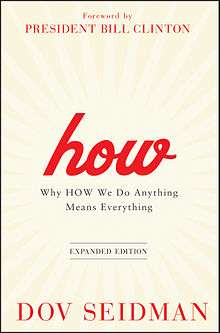How (book)
 How 2011 edition cover | |
| Author | Dov Seidman |
|---|---|
| Subject | Organizational behavior |
| Published | 2007 |
How is a 2007 book on organizational behavior. It has been cited frequently by New York Times columnists Thomas Friedman and Andrew Ross.[1][2][3][4][5] Since 2011, The HOW Column has appeared in Forbes[6] and several international publications[7][8] and previously appeared in Business Week.[9] How has been a presentation topic at the World Economic Forum,[10] the United Nations[11] and the Aspen Ideas Festival.[12]
Overview
Organizations
In The World is Flat, by New York Times columnist Thomas Friedman, How is number eight in his rules for the new world: "HOW you do things as a company matters more than ever."[1]
According to How, the most sustainable organizations are also the most moral — via "sustainable values" (as opposed to "situational values"). Such organizations have a culture of sustaining human relationships integrated into their daily practices.[13]
The theory has been questioned in Strategy + Business by an editor who argued that among "the most successful companies were quite a few that were known for visibly amoral — or, in some cases, exploitative — values and practices."[13] But Seidman maintains the global trends of interdependence and transparency will make such behavior increasingly difficult to sustain.[13]
How says a better way than rule making, or top down command and control is for community members to regulate and guide their own behavior based on shared values. How says there three models of organizational governance, culture and leadership: "Blind Obedience", "Informed Acquiescence", and "Self-Governance."[14] How promotes self-governance as the most transparent, values-based model and therefore, most likely to facilitate "principled behavior."[15]
In an independent study of several thousand corporate employees conducted by Boston Research Group, and designed by Dov Seidman's company, LRN, 43% of company cultures were top-down management; 54% were "informed acquiescence" and 3% were "self-governance."[16] More than 90% of employees in self-governing firms, and two-thirds in the informed-acquiescence category, agreed that "good ideas are readily adopted by my company." At blind-obedience firms, fewer than one in five did.[16]
Applications in society
A wide range of organizations have engaged in formal How education. These include the NFL,[17] the U.S. Army,[18] and Kelloggs.[19] U.S. Army Chief of Staff Ray Odierno included the How book on his recommended professional reading list in 2012 and 2013.[20][21]
References
- 1 2 Friedman, Thomas (2005). The World Is Flat. Farrar, Straus and Giroux.
- ↑ Friedman, Thomas (January 6, 2015). "Time for a Pause". New York Times. Retrieved 25 October 2015.
- ↑ Friedman, Thomas (23 August 2014). "Order vs. Disorder, Part 3". New York Times. Retrieved 25 October 2015.
- ↑ Friedman, Thomas (May 15, 2010). "A Question from Lydia". New York Times. Retrieved 25 October 2015.
- ↑ Sorkin, Andrew Ross (3 February 2014). "Too Many Sorry Excuses for Apology". New York Times. Retrieved 25 October 2015.
- ↑ Seidman, Dov. "The How Column". Forbes.com. Forbes. Retrieved 11 November 2015.
- ↑ Seidman, Dov. "La Columna How". Semana Economica.
- ↑ Seidman, Dov. "Dov Seidman Chroniques de Dov Seidman". JDN. Retrieved 14 November 2015.
- ↑ "Articles by Dov Seidman". Business Week. Retrieved 14 November 2015.
- ↑ "Dov Seidman". Word Economic Forum. Retrieved 25 October 2015.
- ↑ "From Leadership to Reality, Leadership for the future corporation with Dov Seidman - 2014 LEAD Symposium: The Future Corporation". U.N. Web TV. United Nations. Retrieved 25 October 2015.
- ↑ Dov Seidman and Thomas L. Friedman (speakers). "Inspirational Leadership and Sustainable Values". AspenIdeas.org. Aspen Ideas Festival. Retrieved 14 November 2015.
- 1 2 3 Kleiner, Art (29 May 2012). "The Thought Leader Interview: Dov Seidman". Strategy + Business. Retrieved 27 May 2015.
- ↑ Kostigen, Thomas (4 November 2011). "How we work is as important as what we do". MarketWatch. Retrieved 10 June 2015.
- ↑ Haaretz.com "Dov Seidman's secret: You don't have to be a sucker to succeed", July 1, 2012
- 1 2 "The view from the top, and bottom". The Economist. 24 September 2011. Retrieved 14 November 2015.
- ↑ Pompei, Dan (24 March 2014). "Can This Man Help Save the NFL's Soul?". SportsOnEarth.com. Retrieved 8 June 2015.
- ↑ Seidman, Dov (21 April 2014). "Army's Basic Training Is No Longer Basic: Lessons for Business". Forbes. Retrieved 25 October 2015.
- ↑ "LRN's "HOW-A New Lens" Course Brings New Focus to Kellogg's Efforts to Inspire Values-Based Behavior". LRN.com. LRN. Retrieved 25 October 2015.
- ↑ "Ray Odierno’s Reading List". SmartWar.org. Retrieved 30 October 2015.
- ↑ Chief of Staff's Professional Reading List (PDF), United States Army Center of Military History, 2013